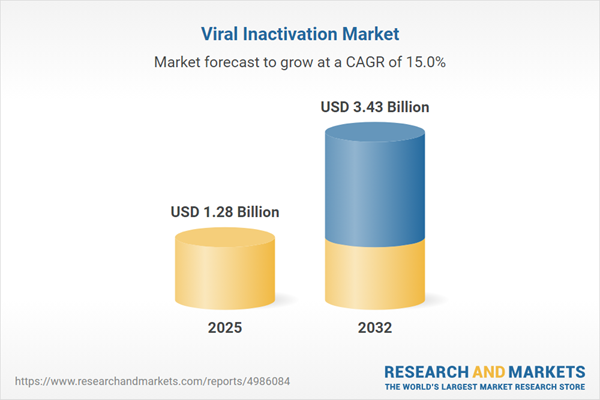Speak directly to the analyst to clarify any post sales queries you may have.
The viral inactivation market is rapidly transforming as organizations prioritize risk management and align operations with changing regulatory frameworks. Senior leaders are adapting strategies to navigate evolving risks and maintain resilient operations in light of dynamic industry demands.
Market Snapshot: Viral Inactivation Market Overview
The viral inactivation market demonstrates considerable value and a consistent compound annual growth rate (CAGR), signaling ongoing sector expansion and resilience. Demand is driven by heightened concerns around biological threat mitigation, with a concentration in the pharmaceutical, biotechnology, and food safety industries. Across these sectors, companies face continual adjustments due to more stringent regulatory oversight and the introduction of rigorous compliance criteria. This dynamic climate encourages both established firms and emerging players to invest heavily in research, development, and new technology integration, supporting agile responses to complex operational and regulatory needs.
Scope & Segmentation of the Viral Inactivation Market
This report details segmented insights designed to support market entry strategies, facilitate portfolio development, and ensure compliance across global markets. The segmentation emphasizes the market’s diversity in solutions, technologies, and end users, offering clarity for decision-makers managing biological risks and regulatory requirements:
- Product Segments: Includes chemical kits, disinfectant substances, ultraviolet lamps, filtration units, irradiation equipment, and sterilization systems. Solutions accommodate rapid-response needs and seamlessly integrate with high-volume manufacturing.
- Method Categories: Covers chemical techniques such as chlorine dioxide and hydrogen peroxide, thermal procedures, electron beam, gamma irradiation, and ultraviolet system approaches. Each method is selected to address unique safety and regulatory challenges.
- Application Areas: Encompasses air purification, food and beverage safety, pharmaceutical manufacturing, and water treatment, supporting contamination prevention and robust standards compliance.
- End User Profiles: Solutions are tailored to biotechnology firms, food and beverage manufacturers, healthcare organizations, and research institutions, with a focus on compliance and ongoing innovation.
- Regional Coverage: Evaluates the Americas, Europe, the Middle East & Africa, and Asia-Pacific, addressing how differing regulatory climates shape technology adoption, solution customization, and partnership strategies.
- Key Companies Evaluated: Ecolab Inc., STERIS Corporation, 3M Company, Thermo Fisher Scientific Inc., Merck KGaA, Sartorius AG, Danaher Corporation, Lonza Group AG, Repligen Corporation, and Novasep SAS, examined for compliance strategies and adaptability.
Key Takeaways: Strategic Insights for Decision-Makers
- Emerging ultraviolet and electron beam technologies foster higher safety standards and agile compliance across diverse operational settings.
- Digital validation tools are streamlining procurement, approvals, and quality assurance, encouraging transparency and operational speed.
- Sustainable design principles are guiding the next generation of viral inactivation solutions, reinforcing environmental compliance and strengthening governance practices.
- Flexible workflows allow organizations to adjust operations efficiently in response to regulatory updates, reducing risks of workflow interruptions.
- Regional partnerships facilitate rapid solution customization, enabling businesses to adapt strategies quickly to evolving local regulatory and operational conditions.
- Tailored approaches in Asia-Pacific and Europe support advanced compliance management, addressing the needs of markets with varied operational structures.
Tariff Impact on Viral Inactivation Supply Chains
Recent tariff shifts in the United States have prompted organizations to diversify supplier networks and explore regional manufacturing alliances. These initiatives increase procurement agility and reinforce supply chain stability, helping stakeholders respond to regulatory and market fluctuations with greater resilience.
Methodology & Data Sources
Findings in this report derive from a multi-sourced methodology: expert input from senior executives and engineers, comprehensive regulatory analysis, and review of patent and public-domain records. This blend of perspectives ensures the guidance remains actionable and relevant for executive decision-making.
Why This Report Matters
- Presents in-depth insights into evolving viral inactivation market trends, technology advancements, and shifting regulatory frameworks to enable strategic, evidence-based decisions.
- Equips leaders with actionable recommendations for optimizing supplier relationships, upgrading procurement, and building organizational resilience in a rapidly changing risk landscape.
- Prepares organizations to proactively meet policy changes and implement sustainable best practices within large-scale risk mitigation efforts.
Conclusion
With a focus on actionable intelligence, this report positions senior leadership to enhance technology adoption, meet regulatory requirements, and implement adjustments necessary for long-term, sustainable success in the viral inactivation market.
Additional Product Information:
- Purchase of this report includes 1 year online access with quarterly updates.
- This report can be updated on request. Please contact our Customer Experience team using the Ask a Question widget on our website.
Table of Contents
3. Executive Summary
4. Market Overview
7. Cumulative Impact of Artificial Intelligence 2025
Companies Mentioned
The companies profiled in this Viral Inactivation market report include:- Ecolab Inc.
- STERIS Corporation
- 3M Company
- Thermo Fisher Scientific Inc.
- Merck KGaA
- Sartorius AG
- Danaher Corporation
- Lonza Group AG
- Repligen Corporation
- Novasep SAS
Table Information
| Report Attribute | Details |
|---|---|
| No. of Pages | 182 |
| Published | November 2025 |
| Forecast Period | 2025 - 2032 |
| Estimated Market Value ( USD | $ 1.28 Billion |
| Forecasted Market Value ( USD | $ 3.43 Billion |
| Compound Annual Growth Rate | 15.0% |
| Regions Covered | Global |
| No. of Companies Mentioned | 11 |









